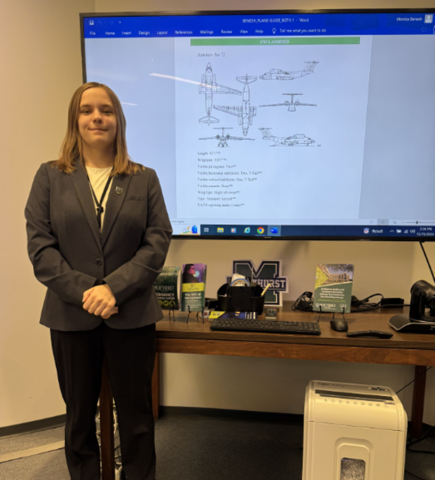Intel student’s Russian aircraft database earns praise from U.S. Army
Monika Benesh never expected a class assignment to open doors to the U.S. Army, but that’s exactly what happened.

As part of her studies in Mercyhurst University's Intelligence Studies program, the Hamburg, New York, native meticulously compiled a 98-page database cataloging Russian military and civilian aircraft, using only open-source materials. She scoured publicly available information, piecing together details until she had something she couldn’t find anywhere else—a comprehensive reference guide.
Realizing the potential value of her work, Benesh decided to take a chance. She shared her research with an Army representative on campus, thinking, maybe they’d be interested.
She didn’t have to wait long for an answer.
The very next day, an email landed in her inbox: The Army wanted to publish her entire document on the OE Data Integration Network (ODIN), a key digital hub used by the U.S. Army’s Training and Doctrine Command (TRADOC) to support military training, education, and leadership development.
That news alone was a major validation of her efforts. But the surprises didn’t stop there.
“TRADOC was so impressed with Monika's work they invited her to visit their headquarters in Fort Eustis, Virginia, over spring break,” said Brian Fuller, executive director of the university’s Center for Intelligence Research, Analysis, and Training (CIRAT), under whose guidance Benesh completed her project.
“They want her to spend time in different sections of the TRADOC footprint so she can get a snapshot of all the different jobs available. They’re hopeful she’ll want to come work for them.”
For Benesh, the experience has been nothing short of surreal. When she first learned the Army wanted to publish her work, she was thrilled. But an invitation to visit TRADOC? That was beyond anything she’d imagined.
"Well, I honestly never expected anything like this would ever happen to me,” she said. “I worked on the project and meticulously chose where I found my sources to ensure accuracy, but never really assumed that it would amount to anything. I’m beyond honored that the U.S. Army TRADOC chose not only to adopt my document but also invited me to their headquarters. I’m especially excited to meet the people behind TRADOC, the analysts working hard day in and day out, since I know I can learn a lot from them."
One thing is certain: What started as a school assignment has turned into a once-in-a-lifetime opportunity—one that might just shape the course of her future.